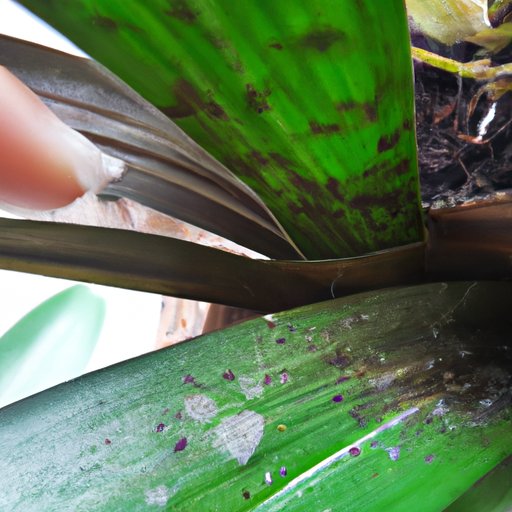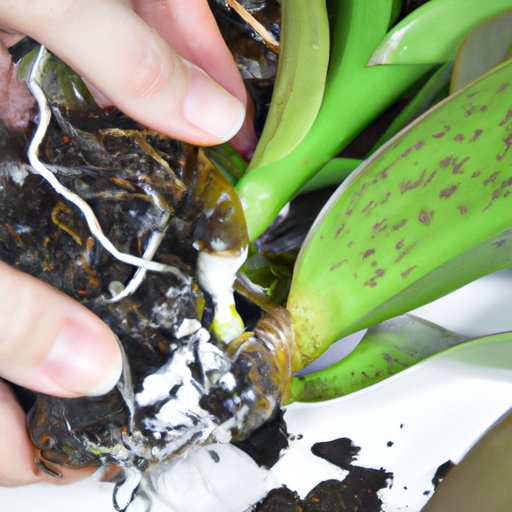I. Introduction
Orchids are one of the most popular houseplants around the world. With their vibrant colors and unique designs, they add elegance and beauty to any room they’re in. However, taking care of an orchid can be a significant challenge, especially if you’re new to the plant. Many of us are hesitant to buy one because we don’t know how to keep it alive. That’s why we’ve created this guide, to help you on your orchid care journey.
In this article, we’ll take you through everything from pot and soil mix to lighting, temperature, watering, and fertilizing, as well as pruning, managing pests and diseases, and creating the ideal environment for your orchid. By the end of this guide, you’ll have a better understanding of how to take care of your orchid and help it thrive.
II. Choosing the Right Pot and Soil Mix for Your Orchid
The right pot and soil mix are essential for the healthy growth of your orchid. Orchids are not like other houseplants and require special pots and soil mixes to grow correctly. Choosing the right size pot and suitable drainage system are crucial parts of the orchid care journey.
Choose a pot that is slightly bigger than the current pot of your orchid because it needs room for the roots to spread out. Ensure that the pot has enough drainage holes to allow excess water to flow out, preventing root rot. Using a porous soil mix that contains bark, moss, or perlite is ideal for orchids. It allows air to flow freely and prevents moisture from settling at the roots of the orchid.
III. Proper Lighting and Temperature for Optimal Orchid Growth
Light and temperature are vital for the growth and development of orchids. They are naturally found in tropical environments and need the right balance of warmth and light to thrive. Different levels of light and temperature can impact your orchid’s growth and development.
When choosing the right light for your orchid, ensure it doesn’t receive direct sunlight because it can burn the leaves. An ideal solution is filtered or indirect light from a North or East-facing window. The temperature should be between 60– 85°F (16 – 29°C) with proper air circulation and ventilation.
Supplemental artificial light is often needed, particularly during the winter months. LED grow lights can provide the same light spectrum as the sun and are more energy-efficient than traditional bulbs. When using artificial light, it’s vital to research the best type, intensity, and duration suitable for your orchid.
IV. Watering and Fertilizing Your Orchid Properly
Proper watering and fertilizing are essential components for maintaining a healthy orchid. The amount and frequency of watering depend on several factors, including the orchid’s type, pot size, and humidity levels. Generally, it’s better to water less often than over-watering, which can cause root rot and lead to the plant’s death.
The best way to know when to water your orchid is by checking the moisture level of the soil mix. The topsoil should be dry to the touch, and the bottom should still be moist. A good way to do this is by using a wooden skewer; insert it into the soil, and if it comes out dry, your orchid needs to be watered. During summer, plants need more hydration, whereas in winter, they require less.
The best time to fertilize your orchid is during its active growth phase. Orchids require a balanced fertilizer mix of nitrogen, potassium, and phosphorus every three to four weeks during the growing season. It’s essential to follow the instructions closely and avoid over-fertilizing, which can cause damage to the roots.
V. Understanding the Different Types of Orchids and Their Specific Care Needs
There are more than 25,000 orchid species and approximately 100,000 hybrids. Each variety has specific care needs, making it essential to know the type of orchid you have and how to care for it. Understanding the differences among the different types of orchids can help you provide the right balance of water, light, and nutrients.
The most common types of orchids include Phalaenopsis (moth orchids), Dendrobiums, Cattleyas, and Oncidiums. Each orchid type has specific growing conditions, including the right temperature, humidity, and light levels. Read up on your orchid type’s care needs and follow them carefully to help your orchid grow healthily and bloom as expected.
VI. Pruning and Trimming Your Orchid to Promote Healthy Growth
Pruning and trimming are essential components of orchid care. Orchids are known for their aerial roots, which can grow in all directions. They can also be prone to overgrowth, which can weaken the plant and reduce flowering. Pruning can help promote healthy growth by removing dead leaves and branches.
Orchid pruning should be done regularly and should only be done when the plant is actively growing. Prune the stems below the last flowering node to stimulate new growth. You should always use sterilized scissors or knife to prevent the spread of disease and ensure proper healing.

VII. Managing Pests and Diseases That Can Harm Your Orchid
Orchids can be susceptible to pests and diseases that can harm their growth and health. Common pests include spider mites, mealybugs, and scale insects, while common diseases include root rot, bacterial soft rot, and leaf blight, among others.
It’s essential to observe your orchid regularly for any signs of pests or diseases. If you notice signs of infection, isolate the plant to prevent the spread of pests and use a suitable pest control or fungicide product. Start by cleaning the leaves with a damp cloth or a soapy solution, and then treat them with the appropriate insecticide, following its labeling guidelines carefully.
VIII. Creating a Suitable Environment for Your Orchid to Thrive, Including Humidity and Air Circulation
Humidity and air circulation are crucial components for maintaining a healthy orchid environment. Keep humidity levels between 40-60% by using a humidifier, pebble tray, or misting. Improper air circulation can cause stagnant air, increased humidity, and an environment that promotes bacterial and fungal growth.
Ensure that the room where you place your orchid has good ventilation and that there is natural air circulation from a fan or open window. Avoid placing your orchid near any drafts or heating vents, which can cause temperature and humidity fluctuations and harm the plant.
IX. Conclusion
Caring for an orchid can be quite a task for many people, particularly if they’re new to it. However, with the right guidance and care, these magnificent plants can thrive and bloom beautifully. This article has provided comprehensive guidance about caring for your orchid, from choosing the right pot and soil mix to pruning, managing pests and diseases, and creating a suitable environment for your orchid to thrive.
Always remember that every orchid species has specific needs, and it’s crucial that you become familiar with its requirements to keep it healthy. With attention and care, you’ll have a beautiful orchid that will bloom for years to come.
For more information on orchid care, you can consult your local nursery, join an orchid club or society, or read up on orchid care in book sources or websites.
